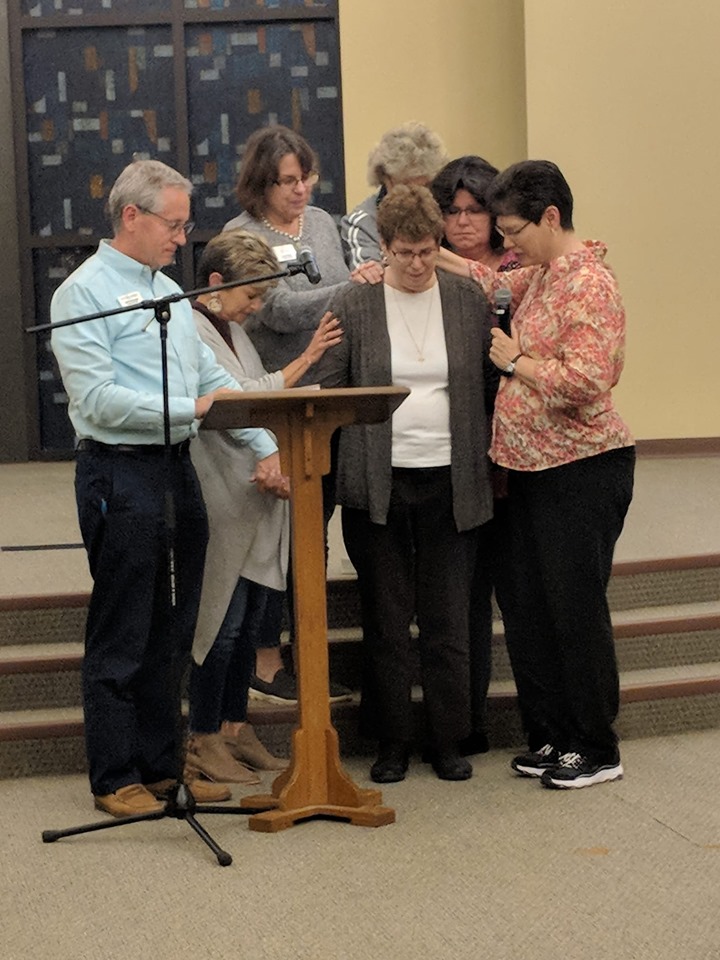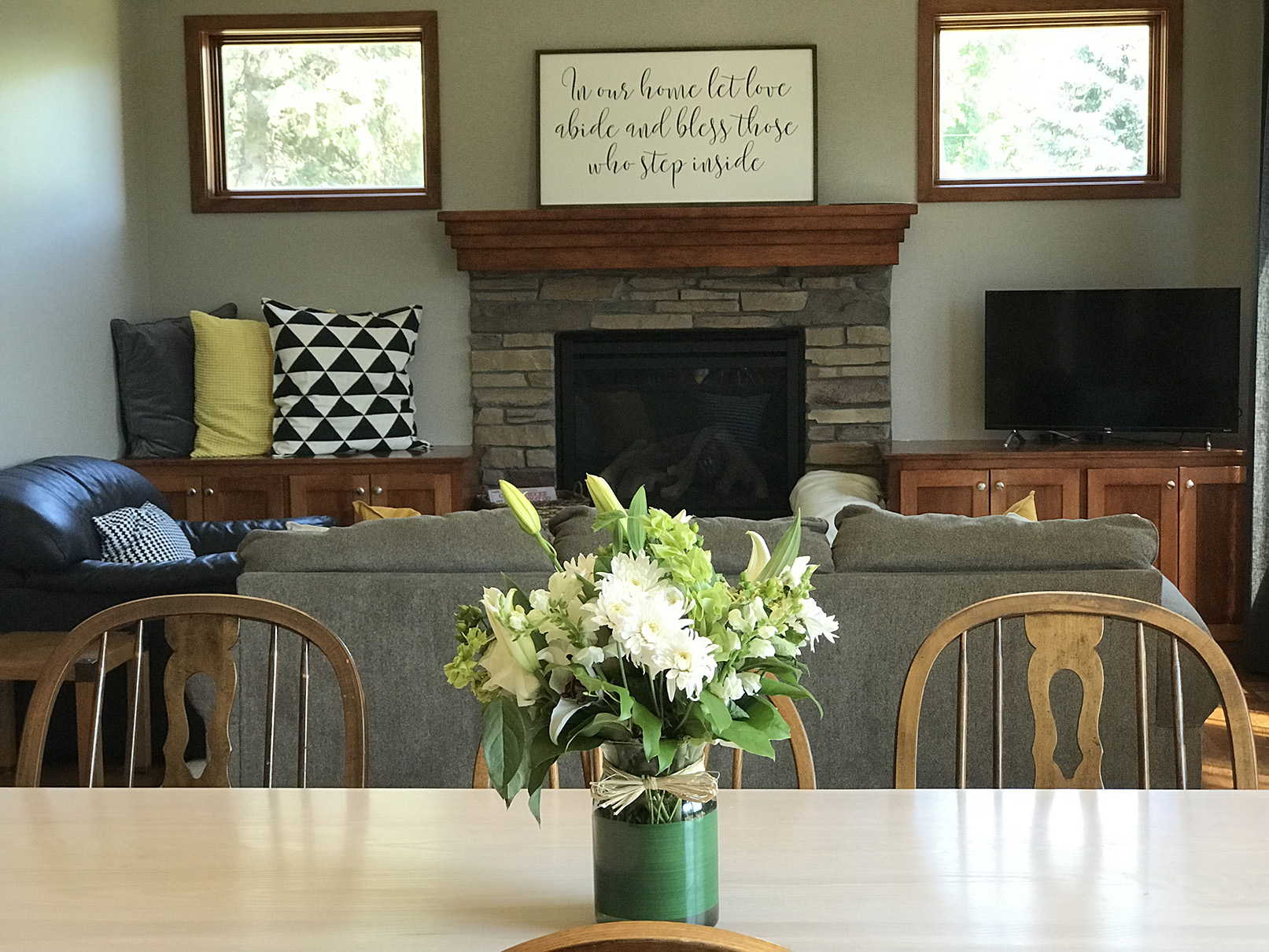Displaying items by tag: housing
Emotional Intelligence: Responding with Purpose
by Mary Peterson, Housing Specialist![]()
Heartbeat International
Many housing programs are exploring the topic of emotional intelligence, or "EQ", helping the mothers to identify and name their emotions. "So many of our residents are emotionally raw," Kathleen Miller of Living Grace Home described, "they don't realize that their emotional responses may be keeping them in a bad cycle." One of the principles of EQ is that emotions show up in our heart, head, and body. To experience healing in those areas, emotions have to be recognized and addressed. "The residents know sad, mad, angry, happy," Beckie Perez of 29:Eleven Maternity Home expressed, "but, when they have more descriptive words for their feelings, they can see them more clearly." She continued, "As the saying goes, 'name it to tame it'. We want the moms to respond with purpose and control rather than impulsively."
One such teaching resource comes from Angie May, the trainer and coach of Kairos Koaching. She has developed a presenter's guide, worksheets, and informational cards as a tool for homes to use to introduce the practical skills associated with Dialectical Behavioral Therapy. "It's a practical model that gives usable tools for organizations and can be a game changer in meeting the real needs of women," she described. The model focuses on four key areas: mindfulness, distress tolerance, emotional regulation, and interpersonal skills.
"Not all programs can have a therapist on staff," she reflected. "This program allows clients to build life skills based on the therapeutic model of Dialectical Behavioral Therapy but using the existing staff." Lynnette Carter from Living Hope Centers agrees, "We were struggling to help our residents learn these skills without a professional counselor on staff. This content helped us figure out a critical piece that we were missing."
An example of one skill that May teaches is strengthening "wisemind" in residents. May summed up the concept saying, "Wisemind is combining the emotional mind and the reasonable mind in the present moment for good decision-making." It involves an emphasis on staying in the moment, the place where healing happens. Many of the tools she advocates for are related to identifying strategies in advance -- for example, having a distraction plan when overwhelming emotion hits or having an idea on how to handle distressing situations.
Angie May did a webinar outlining the content for Heartbeat. If you are interested in learning more about her approach, check out the recording of her webinar (remember to log in for your affiliate discount!) or connect with Angie at KairosKoaching.com. To jumpstart a conversation on Emotional Intelligence, join the National Maternity Housing Coalition Facebook group.
Celebrating Anne Pierson
 Anne Pierson is a memorable soul – A pioneer. A founder. An author. A mentor. A mother & friend. Surrounded by housing peers, this noteworthy woman was awarded a Lifetime Legacy award on October 28 from the National Maternity Housing Coalition. “Anne has always been one of my role models since the moment I met her,” Peggy Hartshorn, Board President of Heartbeat International described, “I admire her both as an individual and as an example of ministry as a couple.”
Anne Pierson is a memorable soul – A pioneer. A founder. An author. A mentor. A mother & friend. Surrounded by housing peers, this noteworthy woman was awarded a Lifetime Legacy award on October 28 from the National Maternity Housing Coalition. “Anne has always been one of my role models since the moment I met her,” Peggy Hartshorn, Board President of Heartbeat International described, “I admire her both as an individual and as an example of ministry as a couple.”
Anne loves singing, puzzles, and striking up conversations wherever she goes. Her love takes the form of being able to focus deeply on the individual in front of her and speak to their heart. She gives “words” as a spiritual ministry to encourage and direct. She has lived a rich life of relationship, having touched many lives with her expertise and genuine love.
As an only child, Anne longed for the large extended families she saw in her childhood neighborhood. Her husband Jimmy had a deep yearning to be a father even as a youth. Both of these desires were realized in the unique extended family they created together. They wed when Anne was 18 years old and together, they had two daughters, Holly and Shelly. As youth ministers early in their marriage, Anne and Jimmy encountered a young woman who was pregnant due to rape. This encounter began a lifetime journey of service to women and children.
Anne and Jimmy welcomed over 200 pregnant women into the context of their personal home, opening their doors to women in need of support. The family life that was shared together is the source of many of Anne’s great stories and insights and Anne has stayed in touch with many of these families for years and years. Their personal efforts became formalized in the founding of a nonprofit, House of His Creation, in 1972. Following many years of direct service, the Pierson’s were publicly recognized in a speech made by President Reagan. This prompted other individuals and ministries needing help to reach out and eventually, led to the development of a new ministry.

Anne began writing materials and in 1984, founded Loving & Caring, an international ministry to provide resources, materials, and practical tools for those in the pregnancy help movement. The My Baby and Me workbook series remains a valuable tool in the pro-life movement, especially in supporting the exploration of adoption. Anne played a key role in the establishment of the National Christian Housing Conference.
As a speaker, she has brought the pro-life message to a variety of settings including conferences, churches, and retreats. A natural storyteller, Anne brings a spark of humor and light-heartedness, illustrating her teachings with tales from her life. She is passionate about the impact of fatherlessness, the beauty of adoption, and the model of family.
“Anne’s years and years of service have shaped the maternity housing community in profound ways,” Mary Peterson, facilitator of the National Maternity Housing Coalition, noted. “She introduced and gave shape to a new model of ministry which inspired many to take up the work. Her work continues in the leaders she has formed who continue to serve with great conviction and passion.”
Over the course of their service, Jim and Anne received Heartbeat’s inaugural Servant Leader Award in 1996. Years later, they also received a 2011 Legacy Award, part of a very small community of those who have been honored with both. Following Jim’s passing in 2012, Heartbeat established a scholarship in his name to support a housing organization in attending the conference.
In recent months, Pierson has announced that the next season of her ministry will be closer to home. A resident of Lancaster, Pennsylvania, Anne is involved with ministries and churches in that community. She has a rich family life including 3 grandchildren and great-grandchildren.
Speaking with conviction, Hartshorn summed up Anne’s legacy in this way, “Anne is an incredibly wise woman – versed in human nature, able to see what women really need, and willing to pour herself out with genuine love.”
As the Lifetime Legacy award noted, Anne Pierson has indeed “fought the good fight and finished the race.” (2 Timothy 4:7)
Designing a Home
by Mary Peterson, Housing Specialist
Heartbeat International
I recently downloaded a game on my phone for interior design. You are given a shell of a room and have to choose the perfect sofa, rug, and accent tables to meet the design briefing. There is a weird satisfaction for me in finding the find combination of color and balance and scale for a room – even though my own home is FAR from an interior design masterpiece! But, the game came to mind as an analogy. There are design elements to consider when creating a maternity housing program, all of which require balance and attention.
Here’s my take on the “fresh” key program design elements to consider in your maternity home:
- A lived Christian experience. What better way to make the Gospel relevant than to be immersed in an environment of genuine Christian love? So many of the principles of our Christian life are now the basis of “research-based practices” – meaning, compassion, whole-person thinking, balancing autonomy with community, and more. Christ’s message continues to be for the flourishing and healing of our human nature – and social science is discovering that! Our homes create a safe place for “church” to be experienced by women who may have dismissed Christianity.
- Resiliency skills. When you research “resiliency skills”, there isn’t a set list but some general themes emerge. These include spirituality, managing strong emotions, movement/exercise, breaking down a big goal into smaller tasks, social support, playfulness, and more. The research shows it is these types of activities and proficiencies that help hurting people overcome. It would be an interesting exercise to think deeply about being hyper-intentional about building these skills into your program – either explicitly (via a class, activity or curriculum) or implicitly (via your culture, policies and dynamic).
- Trauma-aware approaches. There is undoubtedly a trend toward understanding the impact that prolonged toxic stress, especially during formative years, has on the well-being of clients over time. New knowledge of brain science is impacting how we think about the policies and practices of our work. As maternity homes are exposed to the ideas related to trauma informed care, we are seeing a variety of shifts in language, approach, and policies of programs.
- Faster Intakes. As maternity housing programs grow in their knowledge of trauma-informed care, programs are exploring a simplified intake process. Instead of an in-depth exploration of her life’s journey, programs have begun experimenting with asking a limited number of questions, primarily focused on issues of safety. Additionally, there is a shift toward “opt-in” thinking with programs asking “Will this woman benefit from our program?” rather than “Does she fit our criteria?”
- Longer Services. Often healing work takes time, relationship, and stability. We know that intuitively and the research backs it up. We’ve seen the trend toward longer stays at maternity homes for many years and now, there seems to be a high amount of interest in post-residential programming for ongoing support once the mothers leave the maternity home. In addition, homes are feeling the vacuum of fewer transitional housing programs due to shifts in federal funding priorities and there is significant exploration by maternity housing programs to provide apartment-style units.
There is no “perfect living room” in the design app I’ve been playing—it’s a matter of one’s own personal style with the limitations of available resources plus some principles of design. Similarly, there is no “perfect model” of maternity home. But the elements mentioned above provide some principles of design worthy of consideration as you create a beautiful maternity housing program.
Slip, Trip, and Fall: Five Safety Tips for Maternity Homes
by Mary Peterson, Housing Specialist  of Heartbeat International
of Heartbeat International
Fall is here! With this great season, we think about football, pumpkin spice, and…baby safety?!?! Yep, in addition to being the time of shifting weather and changing leaves, September is recognized as Baby Safety Month.
In the spirit of recognizing the role of having a safe environment, here are a few safety tips that impact a group living environment, especially with newborns:
1. Wash your hands. When you read about promoting health, especially in group environments, handwashing is ALWAYS mentioned as the key starting place. Whether it’s singing silly songs, giving the stink eye, or side-by-side modeling the behavior, figure out a way to create a culture of clean hands. (Note: Stink eye, while a technique used by moms everywhere, should be used only in special circumstances.) If pretty-smelling soap promotes the distraction of germs, it’s worth the investment!
2. Use products according to directions and the child’s age, weight, and developmental needs. That’s the big one given by the promoters of Baby Safety Month so I thought I should feature it! At maternity homes, we are pretty good at “making do”—but when it comes to the well-being of our little ones, I like the motto, “When in doubt, throw it out.”
3. Be attentive to sleep safety! It’s a tough one to convince sleep-deprived mamas and nearly impossible to regulate, I know! But having safe practices around sleep will give peace of mind and hopefully, better sleep to everyone involved. Maybe we could share creative ways to talk about safe sleeping in our Facebook group?!?
4. Be attentive. Watching moms engage deeply with their child(ren) is one of the joys of maternity home life. Whether engaging playfully, meeting the baby’s needs, or watching for safety hazards, homes should be a source of encouragement for the mother’s active participation in the life of her child. The habit of managing distractions—especially with gadgets constantly at our fingertips—is a great life lesson!
5. Prevent slips, trips, and falls. These everyday hazards are a common threat to kids—and adults!—of the house. Pregnant women may not easily see the underfoot and falling objects that can be dangerous to infants on the ground or in cribs. Be aware of cords, ice, and other hazards. Teach the adults of the house (staff, volunteers, and residents) to turn on “risk assessment” eyes as they observe the environment!
Let’s raise a pumpkin spice latte to the safety of our homes! May they be places of well-being and protection!
And Then There Were Two
by Mary Peterson, Heartbeat Housing Specialist
Since 2015, the program was called Esther Home. But, when God presented an opportunity for growth, Amber Hornsby, Co-Founder and Executive Director, jumped at the chance to become Esther Homes. After a long season of feeling the Lord prepare the organization for increase, the dream was fulfilled when their second home opened in July 2018.
"We are renting from a church," Hornsby described, "and grateful for the opportunity to come along side of families together to serve them and meet their needs." Esther Homes welcomes pregnant and parenting women, often with young children, for up to two years to "do life together".
Hornsby noted several challenges related to growth, "The biggest fear in saying 'yes' to expansion is the money aspect. We are doubling our current budget and that means our leadership has to spend more time planning and fundraising."
She also described a process of going back to the drawing board on the program, examining what works and what doesn't. "In some ways, we went back to the dirt in order to refine ourselves. We wanted the second home to carry the heart of who we are so we needed to be able to articulate how we want things done." She summed up the process by noting that the backbone of the two programs is the same but differences arise because each location has unique people, layouts, and neighborhoods that they are within. "The programs are even in different counties," Hornsby quipped. "We had to figure out the implications of that."
When asked to give advice to homes considering expansion, the millennial leader let out a deep breath and said, "Be okay with change and accept that things might shift." She continued, "The work load doubles but time doesn't." Hornby described the importance of training new staff and allowing them to do thier thing while remaining available and encouraging. "You need a team to share the load!"
"You can plan a lot but then you get into it, and there are a lot of unknowns that surface," Hornsby reflected. "I just need to stay positive, take a deep breath, and get creative about coming up with solutions." The leader noted that the commitment of the Board of Directors has grown beyond coming to meetings to include greater availability for discussion, more planning for the future, and more administrative support.
"There is a lot of hype about expansion and a season of time where you feel like 'I don't know what I am doing,'” Hornsby summed up. "But ultimately, it’s about the families we are serving and now, we have a greater ability to meet their needs."
For more information about Esther Homes, please visit their website at: http://estherhome.org/
Like Esther Homes, Ruth Harbor Ministries had been actively exploring expansion and had several disappointments along the way. Trusting God through the process, their second location, a 7,200 square foot home outside of Des Moines, anticipates welcoming women later this month. "There are so many God stories in how this came about," Mark McDougal shared with joy.
The second property will serve as the mother and child aspect of the program, welcoming women from their maternity program as well as women with children. The property has an interesting history having served as the family home of the McCaughey septuplets. "The couple, having become empty-nesters, wanted the home to go to a ministry and continue the legacy of family," McDougal recalled.
McDougal shared story after story of God's provision on the expansion, "A very large church in Iowa rallied behind the project. They were able to bless us by purchasing and furnishing the home as a Lenten project. Truly incredible!"
Part of the process of growth was to think in a more standardized way. "We wanted to be able to duplicate what we were doing and we wanted to be able to talk more clearly about the impact that we are having on women's lives," McDougal shared. That desire led the organization to adopt the Evaluation Tool developed by the National Maternity Housing Coalition and integrate it into programming.
When asked what advice he would give to others considering growth, McDougal responded with, "Obviously, seek God's face and don't get discouraged!" But, he continued, "Preparing staff, Board members, and supporters that the process takes time is super important."
"When organizations grow, leaders have to grow," McDougal reflected. He described the homework and planning that goes into expansion and the need to let go of things that he used to be hands-on about. Having served as the Executive Director for 16 years, McDougal was quick to share, "It’s nothing that I'm doing—this is what God wants and I'm just trying to keep up."
For more information about Ruth Harbor, please visit their website at: http://www.ruthharbor.org/
10 Ideas on Creating an Organization Built to Last
by Mary Peterson, Heartbeat Housing Specialist
When studying organizational development, you learn that the shift between stages is a very challenging season. Moving from founding and early decision making into a stage of sustaining and stability demands different skills and leadership strategies. Below are a few thoughts on things you can do to help ease that transition.
- Get things written down.
Capture big decisions on paper—board policies, staff approaches, programmatic structures. Even if it is as simple as having a place to capture notes, when it is time to draft something like a board orientation or staff handbook, starting with a bunch of notes is a much easier starting place than a blank sheet of paper. - Create systems.
You may know how to generate payroll or the staffing schedule or handle an intake interview. But, often that is all "in your head." Think of forms, checklists, habits, communication tools, and things like them as ways to build a training program that can transfer knowledge and responsibility to other people. - Take time for the big picture.
Trainings, retreats, and other opportunities allow you to step back from the day-to-day tasks and think about your work in a new way. It also gives you an opportunity to re-engerize during challenging seasons. - Make room for planning work.
When it feels like you are just putting out fires all the time, taking time to think about the long-term can feel like a huge burden. But, having segments of time to think deeply allows you do infrastructure building work and create strong foundations. - Invest in staff.
Cross-train your staff. Send staff to trainings. Take time for supervision meetings. Delegate to them. By developing leadership in your staff members, you help secure the stability of the organization and can spark an impact that reaches far beyond your organization. - Put some money into savings.
During difficult seasons, having a small savings account might be necessary to weather the storm. Make a habit of saving, even if it is a small amount. - Stay nimble.
Predictability, structures, and plans are great for sustainability. But, change happens all the time—staff members change, laws change, financial realities change. Create an organizational culture that doesn't panic when it has to adapt. - Build traditions and tell your story.
Organizations can create a rich identity by taking time to celebrate key moments via traditions. Create opportunities to reflect on organizational experiences and memories. - Talk and pray about the future.
The future includes the staff who will follow, programs that will change, and volunteers and donors who will be called to the work. Set a tone and expectation that a bright future exists that involves new people and new ideas. - Build an organizational identity that isn't dependent on one person.
Anchor people to the mission of the organization, not to a charismatic personality. Having key supporters in relationship with multiple people eases the burden on the leader and maintains continuity when transitions happen.
Spring in the Desert
by Mary Peterson, Heartbeat Housing Specialist
I live in the midst of the desert - it's easy to look on the landscape of cactus and sand and just see brown, barren land. But, even here, it is spring. The mesquites have sprung out with tiny leaves; the jackrabbits seem to be everywhere, and a hint of green can be seen on the mountainside. I saw a family of baby quail hiding in a plant the other day and couldn't resist cooing in delight.
In the work of maternity housing, we encounter the nitty-grittiness of life on a daily basis. Some of those situations are fairly typical of the human experience - supporting women who are dealing with the discomfort of pregnancy, facing a difficult decision, or trying to develop new skills.
Other aspects of our everyday reality are extremely challenging - serving adult women struggling with basic hygiene, traumatic experiences, addiction, or abuse in their relationships. Women choosing to remain in patterns of behavior that appear selfish or self-destructive. We have to deal with the reality of asking women to leave our homes, a sometimes brutal transition from a place of safety to a challenging and uncertain future. We get accused of being a much worse and a much better person than we really are.
This reality - of maternity housing - can be very heavy, and at times of exhaustion or overwhelmedness, it can seem bleak or depressing.
But, like spring in the desert, there are signs and indications everywhere of a different reality.
- A genuine conversation.
- A positive interaction.
- A loving gesture.
- A sacrificing mom.
- An act of forgiving.
- A goal achieved.
When we attune our eyes, there are indications of growth, new life, and goodness emerging.
In the video below, Chris Bell of Good Counsel, shares a difficult scenario that he encountered and transitions into some thoughts on remaining encouraged in the work. May we all remain steadfast in our committment to resist despair and to seek indications of God's goodness at work.
National Maternity Housing Coalition - Chris Bell from Heartbeat International on Vimeo.
The Revolutionary Power of Relationship
by Mary Peterson, Housing Specialist
The pregnancy help movement has long been a advocate of relationship being the central aspect of ministry. Heartbeat developed this principle into a method they refer to as The LOVE Approach which has been taught in countries across the world.
In recent years, brain science and trauma-informed care research has further validated this idea. This area of study is providing new findings and strategies to further develop connection with clients with deep compassion.
Debbie Simmons of Anchor Point has introduced one trauma-informed method, Trust-Based Relational Intervention (TBRI), into her life-saving work. She was so convicted about the impact that TBRI was having in her ministry that she become a trainer on the topic.
"TBRI has revolutionized our ministry and seeing that transformation, you can't help but get excited," Simmons said with passion. "It has taken our ministry to the next level of impact." She continued that TBRI has not only changed the way that she does ministry but also the way that she parents and approaches all relationships.
Debbie furthered described the impact saying, "Our clients are 'kids from hard places' and without a radical difference in their lives, they will raise 'kids from hard places.'" Simmons described how practical differences–things like layout of the building, discipline strategies, and communication tools–can shift a client from having a "fixed mindset" to having a "growth mindset."
"In taking our focus on connection to a whole new level," Debbie described, "our staff needed to have eyes of compassion at a whole new level." For Anchor Point, adopting a TBRI framework provided the training and methods allowed that shift to take place. "It allowed us to see our clients in a whole new light."
Valerie Harkins, Program Director of LifeHouse, has also integrated the TBRI model in the daily functioning of their maternity homes. "The new approach allowed us to move away from power struggles to shared decision making," She continued, "We still maintain authority but do so in a way that respects the woman's deep need to feel safe and in control." For further reading on TBRI, Harkins recommends The Connected Child by Karyn Purvis.
Organizations that are interested in learning more about Trust-Based Relational Intervention can join Debbie Simmons as she presents an In-Depth Day at the Heartbeat Conference in Anaheim, CA on April 10, 2018.
Simmons invited organizations to invest in impact. "These are life and death issues...eternal issues," Simmons asserted, "we want to get them right!"
Dropping the Crayons and Dying to the Specifics
by Hannah Ellis, International Program Specialist
In a recent piece on Pregnancy Help News, Heartbeat shared that Life Choices, a pregnancy help organization in Kittanning, Pennsylvania, is on the verge of opening their first maternity home, “The Inn.”
After hearing the story of the home’s beginnings from Christy Pittman, Project Coordinator, and Bri Sherman, Development Assistant, I noticed a prominent theme that may be helpful to share with others in the pregnancy help movement as you strategize for the future.
In the beginning, Life Choices had a plan for the new maternity home.
Initially, they wanted a large structure that had a lot of rooms (eight, if you want to get specific). Yet, in their searching and looking at properties, God kept bringing them back to the idea of focusing on the relationships with the clients more than the structure of the program. When they began praying through properties, that’s when the funds started coming in and God showed them the house He had for them – a smaller, more intimate house with potential for growth.
Throughout the decision-making process, Christy and Bri realized they also needed to let go of their control over the details of the houseparent situation, and just a week after they did, a couple surfaced who wanted to fill the role.
The team officially closed on the maternity house this summer, and they have begun buying supplies and setting up policies and programming—which, it goes without saying, will be easier to implement in the smaller house. The staff is overjoyed about The Inn, and the official housewarming party will be on September 22, 2017. They are inviting supporters and community members, and are fully anticipating a waiting list.
Life Choice’s motto is “every life valued.” At the new maternity home—named after the inn that was too full for our Lord’s birth—the motto is “two lives at a time.” The Inn offers a safe haven for these women, where there hasn’t been room for them anywhere else. These young women now have a place of refuge where they are free to choose a parenting direction that is best for them.
Proverbs 16 tells us, “We can make our plans, but the Lord determines our steps.” Christy and Bri look back now and laugh about their wanting to be in control and said they’ve “learned to let go and let God move.” He has shown that His faithfulness and provision is beyond their own understanding.
Don’t we do that all too often?
We do more planning than praying and more scheming than surrendering, only to find out God’s design is far better than we could think up or imagine. It’s almost like giving an architect a blueprint for how to build our house. Except, add in the fact that the Architect doesn’t follow human rules or reasoning, and sees the whole picture where we see only a part.
When our Crayola-drawn blueprint gets superimposed with His intricate plan, we are humbled to a place of total trust in His more than capable hands.
What about you? Are you holding on to your design with a tight grip? Or, are you letting God hold the pen as He drafts His intricately beautiful plan? Let’s put the crayons down and instead clasp those hands in prayer, asking God what He wants to do. Trust me; He will blow your mind with what He’ll use you to accomplish.
Ephesians 3:20 – “Now all glory to God, who is able, through His mighty power at work within us, to accomplish infinitely more than we might ask or think.”
There's No Place Like Home
by Mary Peterson, Heartbeat International Housing Specialist
Like Dorothy in The Wizard of Oz, many of the women served by the pregnancy help movement are dreaming of home. A place that is safe. Walls that protect and people who love.
There has been a lot of wild analysis of The Wizard of Oz over the years, trying to unlock the secret meaning of the story. Without venturing too far into that realm, let’s look at the central themes.
Like the Lion, many of the women seeking housing are deeply afraid. That fear might surface as despair, anger, or some other big emotion but, each is looking to the future and afraid of what they see. Being welcomed into a maternity home eliminates some immediate issues and provides the opportunity to find courage for a new path.
Like the Scarecrow, the women might not know what to do, how to start, or where to go. “I don’t know how to be a mom.” “How can I support a child?” The resources provided by a maternity housing program give her practical skills around employment, life skills, and education. And even more important, they build up her wisdom of her gifts and her identity in Christ.
Like the Tin Man, there is a temptation to revert back, to allow things to “rust” and get stuck in old patterns. Maternity homes wrestle with how to invite change in the deepest part of a woman, in her heart. Loving and being loved is transformational. Having stable, caring figures in one’s life allows the possibility of leaving a life of pain to have the fullness of life. Someone can point to the future and say, “I see more for you. I see a vibrant life. I see your heart fully alive.”
For a long time, Heartbeat’s vision for pregnancy help has included the work of housing programs. In recent years, through a partnership with the National Maternity Housing Coalition, a sense of common work has developed amongst maternity housing providers. As homes began talking to one another, we have looked back to the history of maternity housing in order to know where we have been. We have looked at our current realities to understand our similarities and differences. And we’ve begun to look forward to understand how to strengthen existing homes and support the development of new homes.
Our own Yellow Brick Road, if you will.
One strategy is to be a resource for fostering knowledge and skills–and great tools have been developed. One such tool is Maternity Housing Essentials. It’s a guidebook, drawing from the experience of various models and perspectives, to document the key issues related to housing. Laying out the strengths and challenges of various perspectives, the manual invites housing programs to think deeply about their structure and make informed decisions.
A deeper goal is to rally the hearts of those called to or involved in housing. Whenever homes gather, there is a fast sense of “someone who understands.” It’s a work that can be life-giving and draining, all at the same time. By facilitating community and connection, both virtually and in person, Heartbeat is trying to bolster those who give deeply to this important work.
Among homes, there is a great deal of variety in methods. However, there is a strong sense of unity in mission. And that sense of mission reconnects housing to the pregnancy help movement as a whole. Maternity homes exist to support vulnerable women and accompany them through pregnancy related decisions and beyond. In this way, we share a great deal in common with pregnancy centers, pregnancy medical clinics, and adoption agencies.
So, if you find yourself thinking, there is no place like home as you dream about the future, we are ready to help. Just click your ruby slippers together or click here for more information.

